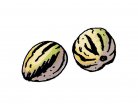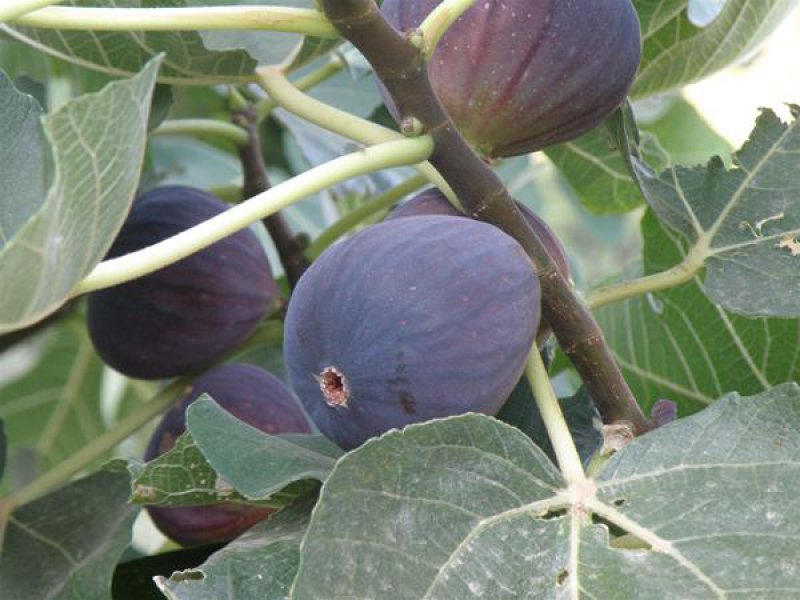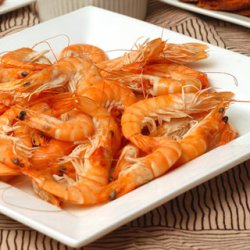The caique sways rhythmically on the blue water. The beginning of September, the light of the sun is sweeter, the shadows are lengthening, colors coming to life again after the August heat wave. The last visitors boarding. We find ourselves at Diafani, headed for the island of Saria off the northern coast of Karpathos. We set off. The atmosphere aboard the caique is festive. Everyone savoring the clarity of the atmosphere and the colors, enjoying the trip. Saria is only 200 meters from Karpathos. We float by a sheer, bare, incredibly high mountain for such a tiny island. The closer we get to Palatia, the harbor of Saria, the more impressive the rocks become. The little harbor, which has been used since antiquity, is utterly charming, with the clearest blue-green I’ve ever seen.
Half of the party immediately dives into the water. A number of us take the path leading to the island’s interior, leaving our refreshing dip for the end of our little tour.
The path that will lead us to the ancient ruins of the settlement of Saria takes us through a narrow gorge. An impressive route. After quite a journey we arrive at the plateau where the ruins of the settlement lie. There is not a soul around, but I still feel that someone is watching us. Here and there, haughty, silent, and mainly curious goats observe us.
It has started to get hot. We are thirsty and hungry. And right here, amongst the ruins and the outhouses that appear to be used seasonally by shepherds, we find food and water. A few gnarled, and dry fig trees full of delicious, sweet figs, and a well with cold water.
"This is place is magical, isn’t it?" said an elderly English lady with us, enjoying the tasty figs in the shade of the large fig tree.
"It’s not just the place that’s magic," I thought, "it’s also the tree you’re sitting under."
The fig tree was one of the oldest trees cultivated by man (7000 BC at Jericho). It’s the first tree mentioned in the Bible. In Greek mythology it is associated with events and divinities which are testament to its "chthonic background," and in India it is a sacred tree. There were ages in our history where the individual consciousness, the strong sense of "self" we have today, did not exist. Our distant ancestors lived in a magical world, one that was more childlike.
Trees, animals, and natural phenomena were not items for study, but creatures of an enchanting world in which man shared. The state of mind that we, today, attempt to achieve via various techniques or with the aid of hallucinatory plants, could be reached more directly at that time.
In those magical, chthonic times, it appears that the fig tree played a mystical role in both religion and ritual. Man’s long journey in the development of human consciousness begins with his fall from Paradise. It is there that the fig is first mentioned in the Bible. And so, once Adam and Eve had eaten fruit from the tree of knowledge, they clothed their nudity with fig leaves and took figs with them for the journey. Perhaps the tree of knowledge had been a fig tree.
The second mention of the fig is made in the Gospel of John (A 47-51): Jesus tells Nathaniel that he recognizes him, having seen him beneath a fig tree. Jesus assures Nathaniel that, from beneath the fig tree, he will see things in a new and different way. The third, and final, reference to the fig tree is in the Gospel of Mark (ch. 11), where Jesus rages against a particular fig tree, saying that no one shall ever again eat of its fruit. Jesus’ words are a reference to old methods of inspiration and vision, that is, the pagan practices that the fig tree once entailed. Through Jesus’ teachings, the Western world embarked upon a new age redolent of new spiritual paths.
Preceding the dawn of Christianity, the fig tree played a major role within Greek mythology. The most direct reference to its "chthonic background" is made in the myth concerning the battle with the Titans. According to the myth, the battles between the allies of Zeus and those of the Titans, the supporters of Cronus, lasted nine years. In the end, the Titans were banished to the bowels of the earth, to dark Tartarus, and Zeus emerged as victor. All of the Titans were plunged into darkness, apart from one: Sykeus re-emerged into the light in the form of a fig tree.
Also according to Greek mythology, the fig owes its existence to the god Dionysus, and was worshipped as a tree of both Dionysus and Priapus. Here too, we have two mythical beings that are contemporaries of Zeus, but also directly related to the "chthonic" powers of reproduction, fertility, and the eternal rhythms of nature. In another myth, Demeter offers the fig tree to the people of Attica, to whose region she had gone in her time of mourning, following Pluto’s abduction of her daughter Persephone.
The fig is not a particularly impressive tree. With its grey trunk and dull, rough leaves, it’s not a tree that one would notice. It is a member of the family Moraceae and the genus Ficus. It originated in Asia Minor, specifically in the town of Caria, and has been cultivated for thousands of years for its especially nutritious fruit, which can be eaten fresh or dried. In reality, the part that is eaten is the bloom and not the fruit. The grey wood of the tree is porous and cannot catch fire. It is moist and contains no resin. Storing moisture in the pores of its wood, the tree can survive great drought.
Strangely, instead of resin, the fig tree produces milk. The ability to yield milk is a rare characteristic within the plant kingdom. Although the other plants that yield milk generally produce substances that are either poisonous or strongly hallucinogenic, the milk of the fig is slightly caustic, thus causing itches and rashes.
The roots of the tree dig deeply into the moist dark earth, while its trunk, leaves, flowers, and fruit reach towards the air and the sun. In the first summery days of spring, blossoming flowers send irresistible aromas into the air. As the temperature increases and most fruit ripen, the fig tree does not follow suit. It does not possess buds that bloom with brightly colored flower petals, nor does it attract insects to facilitate fertilization and thereby create the fruit. Instead, the fig "blooms" inwardly. Small swollen "sacks" form, full of stamens, spores, and juices which, if not consumed, attract insects to disperse them- these are the figs. If they are not gathered up, they rot and fall to the ground.
In tropical forests, there are types of fig that man has named sacred. In the Botanical Gardens of Calcutta, there was- until its destruction in the 1920’s- an unusual tree that was a close relative of the ficus bengalensis, 30 meters high, with a 24-meter trunk circumference, and a 280-meter leaf span. The most impressive thing about this tree was perhaps its 232 external roots which, beginning from various branches and turning towards the ground, supported and fed the giant. This tree, along with the fig-like fruits that it bore, was considered to be sacred to Buddha. In fact, it is said that in the shade of this tree Buddha was both incarnated and enlightened.
From Egypt to Greece to Rome to Russia, there are innumerable stories, myths and rituals associated with the fig tree... but they will not all fit in this article.
The use of the fig in the therapeutic art and medicines of antiquity took many forms and was considerably widespread. Today, the byproducts of the fig tree are no longer used in remedies or therapies, apart from its milk, which is used in obscure regions of Greece against itches. In the Mediterranean diet, however, it continues to play an important role in both summer and winter. There are many different types of figs, some of which are quite famous- like Cyme, Argalasti, Vasilika. Since the fig does not require watering nor cultivation in order to produce sweet fruit, it can be enjoyed as a kind of snack bar by those on summertime trips in the wild countryside.
Figs are rich in vitamins (A, B, and C), minerals (calcium, phosphorus, iron, and sodium) and naturally contain a lot of sugar, thus producing healthy energy. In addition to being easily digested, they help to ensure the proper functioning of the digestive system.
The Enchanting Fig Tree
From Greek mythology through to modern medicine, the fig tree has been renown for its innumerable therapeutic and practical purpose.
Category:
Related Articles
Most Popular recipes



































































